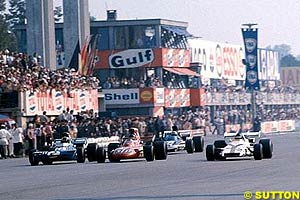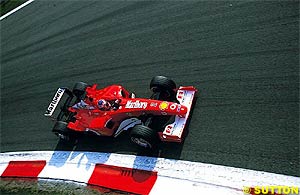
Atlas F1 Magazine Writer
Sunday's Italian Grand Prix got close to becoming the fastest ever Formula One race, but Rubens Barrichello's slow pace during the final part of the event left the 1971 race at Monza still on top of the charts. Both races shared a few similarities despite being 31 years apart. However, they also had a lot of differences. Richards Barnes puts the 2002 Grand Prix in perspective by analysing the fastest race ever: the 1971 Italian Grand Prix
With both Ferraris dropping almost four seconds a lap off their true pace during the final stanza to ensure the desired 1-2 formation finish, Barrichello fell tantalisingly short of the record. The Brazilian completed 53 laps of the much-revised 5.79 kilometre modern Monza at an average speed of 241.09 km/h. Gethin had completed the 1971 event, 55 laps of the old 5.75 kilometre circuit, just a fraction faster at an average speed of 242.62 kilometres per hour.
A year later in 1971, the two F1 championships were as one-sided as this year's championships have been. Tyrrell's Jackie Stewart had already sewn up the Drivers' Championship by the time he arrived at Monza and, much like Schumacher and Ferrari this season, Stewart and Tyrrell went on to dominate both championships, scoring roughly double the number of points as their nearest rivals. Teams in 1971 also had a choice of only two tyre manufacturers - Firestone or Goodyear. So at first glance, it seems like only the names have changed. Yet the differences between Monza 1971 and Monza 2002 serve to bring the sport's current status into stark relief.
Sunday's GP saw four leaders - Williams' Ralf Schumacher for the first three laps, teammate Juan Pablo Montoya for a few hundred metres, and Michael Schumacher for the eight laps between his own pitstop and Rubens Barrichello's. For the rest, it was a dominating Barrichello and Ferrari performance. Despite the caution shown over the closing laps, the scarlet cars beat their nearest rivals to the finish by almost a minute, and the race for the lead contained only two significant passing manoeuvres - Barrichello and Schumacher both outdragging Montoya down the pit straight.
The 1971 race, by comparison, was the most closely-fought in modern GP history. Eight drivers, in six different makes of car, swapped the lead constantly throughout the 55 laps. There were 25 lap-end lead changes, and many more passes that were reversed before lap-end, never registering on the official lap charts. No driver led for more than six laps at a stretch. When the chequered flag came out, 0.18 seconds covered the first four cars - Peter Gethin (BRM), Ronnie Peterson (March), Francois Cevert (Tyrrell) and Mike Hailwood (Surtees). Fifth-placed Howden Ganley's BRM was a 'distant' three-fifths of a second behind Gethin. The Monza win was the only points-scoring finish by Gethin all season, the only win of his F1 career and, incredibly, it came in only his second race for the five-car BRM team, after he'd parted company with Teddy Mayer's McLaren outfit earlier in the season.
Gethin's win was forged from the values of timeless racecraft. Starting like all the others with a race-length fuel load and one set of soft sticky slick tyres, Gethin was never spectacularly fast. On the day, seven other drivers recorded faster individual race laps. But Gethin was always in the frame and, although he only led for three laps in total, the all-important final lap was one of those three.
The 1970's was a decade of almost unparalleled F1 development, from turbine engines to four-wheel drive, quantum leaps in aerodynamic efficiency, six-wheeler cars, wildly-differing air intake configurations, radiators shifted from the nose to the sides of the car, and suspension innovations to combat weight shifts and ensure consistent ride height. Experimentation was rife, and each season the teams would wheel out their new designs with each one distinctly different from the others. Without wind tunnels and telemetry, and without today's vast array of car setup options, theory, speculation and hard experience had to provide the answers.
Today, most of those 1970's innovations have either been accepted as standard to all, or outlawed completely by the sport. The innovation window hasn't been shut completely, but science and regulations have narrowed it to a chink. That has left 'the package' as the differentiating performance factor between the winners and the also-rans.
Williams Technical Director Patrick Head summed it up best when stating that there is no single design feature or characteristic that makes Ferrari's F2002 stand out from the pack. Instead, it's the lack of a weakness, the fact that it does everything well, that makes Rory Byrne's current offering the most dominant car in years.
It's a level of dominance guaranteed to send the opposition into fits of depression. But then, the same could be said about Ken Tyrrell's team in 1971. Just one season later, third year Lotus driver Emerson Fittipaldi had rebounded from a disastrous 1971 campaign and dethroned Stewart and Tyrrell as the sport dominant forces. That's not likely to happen to Ferrari anytime soon. With custom engine and tyres, a top chassis, key team personnel continuity and the sport's top driver, they've pioneered and perfected the 'total package' concept.
The opening seconds of Monza 2002 illustrated just what an advantage it gives the Scuderia. Williams teammates Juan Pablo Montoya and Ralf Schumacher squabbled entirely unnecessarily over the first corner, with Schumacher incurring a penalty in the process. Behind them, the Ferrari pair showed a far more co-ordinated approach, Michael Schumacher giving way to designated hare Barrichello. Once the Brazilian had forced his way past Montoya, another unforced error by the Colombian left him easy prey to Michael, and the Williams challenge had evaporated within half-a-dozen laps.
If Williams and McLaren can't raise their game sufficiently to challenge Ferrari soon, will they at least be joined by another contender, and who will that contender be? It's a question that has ebbed and flowed all season, but no team have shown the consistent improvement required. Sauber and Renault both showed early-season promise, and both have gone backwards through the grid of late. The soon-to-be-renamed BAR, Jordan and Toyota have all showed brief glimpses of potential, and Jaguar joined the fray at Monza after an abysmal couple of seasons.
With the summer silly season extending into autumn, and just two races to run in this year's championship, the midfield fray has become as close, exciting and unpredictable as Monza 1971. Ferrari, McLaren and Williams have ruled F1 for far too long, and a fourth contender is needed to revitalise the sport. If a new contender is to emerge, we'll only get the answers at the start of the 2003 season. But the final two races of the year may provide some telling clues. With Ferrari domination virtually assured at Indianapolis and Suzuka, most of the fans' attention will be on the increasingly intriguing midfield battle.
From the moment that Ferrari's Rubens Barrichello emerged from his second pit-stop barely metres ahead of team leader Michael Schumacher, the main interest at Sunday's Italian Grand Prix lay in Barrichello's attempt to pip Peter Gethin's record, set at Monza 31 years ago, of setting the fastest average speed ever in a Grand Prix.
 The average race speed wasn't the only factor linking the 1971 and 2002 Italian Grands Prix. Both races took place in Monza's trademark hot dry and sunny weather. Both races marked a return to relative normality one year after a particularly muted Italian GP. In 2001, the crowd was in shock and mourning at the terrorist attacks in America. In 1970, the Monza crowd had witnessed the death of Jochen Rindt during free practice the day before the race, brake component failure pitching his Lotus into the barriers at the high-speed entry to the Parabolica. Rindt succumbed to severe chest injuries on the way to the hospital, and was later crowned as F1's only posthumous Champion.
The average race speed wasn't the only factor linking the 1971 and 2002 Italian Grands Prix. Both races took place in Monza's trademark hot dry and sunny weather. Both races marked a return to relative normality one year after a particularly muted Italian GP. In 2001, the crowd was in shock and mourning at the terrorist attacks in America. In 1970, the Monza crowd had witnessed the death of Jochen Rindt during free practice the day before the race, brake component failure pitching his Lotus into the barriers at the high-speed entry to the Parabolica. Rindt succumbed to severe chest injuries on the way to the hospital, and was later crowned as F1's only posthumous Champion.
 Formula One racing is a very different beast today, as witnessed by Sunday's race at Monza. However, that difference is not just the result of the modern grooved tyres or chicane-laden tracks, pitstops, automatic gearboxes, or the fact that the average driver's helmet today bears more sponsor names and decals than the entire car did in 1971. It's about the development curve and the 'package' concept.
Formula One racing is a very different beast today, as witnessed by Sunday's race at Monza. However, that difference is not just the result of the modern grooved tyres or chicane-laden tracks, pitstops, automatic gearboxes, or the fact that the average driver's helmet today bears more sponsor names and decals than the entire car did in 1971. It's about the development curve and the 'package' concept.
Please Contact Us for permission to republish this or any other material from Atlas F1.
|
Volume 8, Issue 38
Atlas F1 Exclusive
Interview with Richard Cregan
Articles
On the Right Track
Monza Madness
Ann Bradsaw: View from the Paddock
Italian GP Review
Italian GP Review
Italian GP - Technical Review
31 Years Ago...
Open Letter to Fujio Cho
Stats Center
Qualifying Differentials
SuperStats
Charts Center
Columns
Season Strokes
Elsewhere in Racing
The Grapevine
> Homepage |